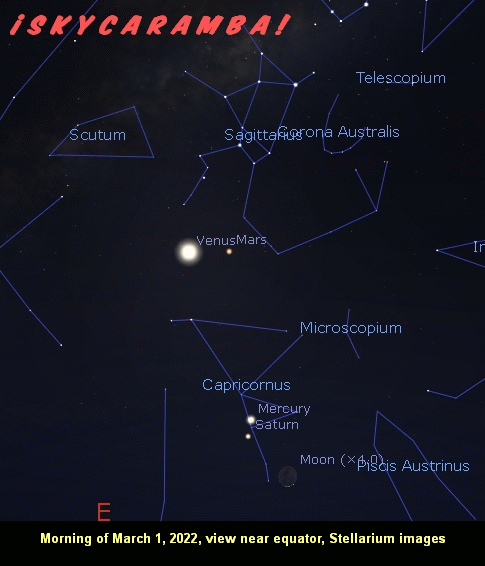All the naked eye planet watching this month is in the morning. A waxing crescent moon rises into the evening through Pisces early in the month. It’ll be near Uranus on the 6th. See the moon passing between the Pleiades and the Hyades on the evening of the 8th. Orion is high in the sky slightly west of the meridian in early evening, followed closely by Canis Major.

The moon is at first quarter on the 10th. It’s at apogee on the same day, 404,400 km from Earth. Lunistice follows on the 12th at 26.7° north. A waxing gibbous moon passes near Pollux on the 13th. The moon is approaching full when it passes by Regulus on the 16th.
Full phase is two nights later when the moon is near Porrima in Virgo. Some sky watchers get to see the full moon pass in front of the star. That’s on the night of the 18th to 19th. Visibility is from most of Canada, the northeastern contintental United States, Greenland, Iceland, and the northern Atlantic Ocean.

The moon passes north of Spica the next night. It’s almost at last quarter when it passes near Antares on the morning of the 23rd. The moon’s at perigee the same day at 369,700 km distance. And it’s in the teapot lid of Sagittarius at last quarter on the 25th. Southern lunistice at 26.8° is also on the 25th.
On the 27th, 28th, and 29th, the moon is a waning crescent passing through the morning planet cluster. This will be a wondrous sight, especially for people close to the equator and south of it.
The morning planet watching starts with Venus and Mars moving side by side and getting closer. They’re 3.9° on the 16th. As these two planets move into Capricornus, the constellation rises earlier. People watching from the middle and high latitudes of the northern hemisphere get to see Saturn coming along for the ride into visibility. Mercury starts the month near the ringed planet, but it’ll be no easy catch from those latitudes. Sky watchers there get to see a triangle of Mars, Venus, and Saturn joined by the moon late in March.
The most spectular views will be from farther south. For viewers there, the month starts with a waning crescent moon below Saturn and Mercury. The two planets are closest, 0.7° apart, on the 2nd. Mercury drops below the ringed planet while Venus and Mars sink to meet it. Follow Mercury as long as you can this month and you may see it close to Jupiter on the 21st. They’ll be 1.2° apart. They’ll be in the glow of the soon-to-rise sun, so you may need binoculars to pick them out.
Venus continues on its way through Capricornus and will be on one side of Saturn with the moon on the other on the 28th. Saturn and Venus are closest, at 2.1°, on the 29th. An even thinner crescent moon passes by Jupiter on the 30th.

Briefly, all four of these planets will be in the boundaries of Capricornus next week. Those are the boundaries recognized by the International Astronomical Union. Venus crosses the line from Sagittarius to Capricornus at about 1 hour UT on the 7th. Mars, Saturn, and Mercury are already there. Mercury crosses the boundary to Aquarius at about 4 hours on the 8th. Of course, you don’t see the boundary lines in the sky. You can just enjoy knowing the planets are within them. For South America, this will be on Monday morning. Africa gets the view Monday and Tuesday. For Australia and Polynesia, it’s on Tuesday. Again, that’s next week.
The morning planet watching stays exciting in April and more of the northern hemisphere gets to see it then.
The March equinox is on the 20th at 15:34 UT. Venus is at greatest elongation on the 20th. It’s 46.6° west of the sun.
